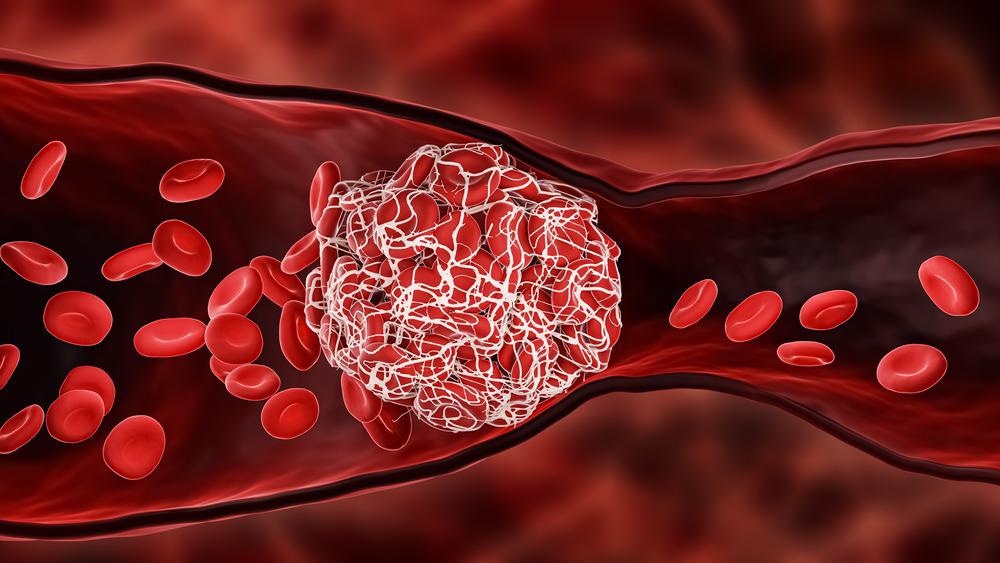Blood is an essential component of the human body; therefore, the loss of this fluid, particularly in large amounts, can be life-threatening. To protect the body against the potentially devastating effects of blood loss events, several vascular mechanisms and biomolecules can be employed to generate a blood clot.

Image Credit: MattLphotography/Shutterstock.com
Despite the crucial role of blood clots in preventing blood loss, the development of specific blood clots like a thrombus or embolus can have deadly effects. Whereas a thrombus is a blood clot that forms inside the veins or arteries, the detachment of this clot from one location in the body to another is referred to as an embolus.
Both thrombi and emboli can prevent the adequate flow of blood through a blood vessel, thus reducing the ability of oxygen to reach these tissues. Some of the most clinically significant blood clots in the heart can lead to conditions including deep vein thrombosis, pulmonary embolisms, mesenteric venous thrombosis, strokes, and heart attacks.
Current Methods to Predict Blood Clots
There are several health conditions that can increase an individual’s risk for a potentially dangerous blood clot. Some of these risk factors include smoking, obesity, pregnancy, prolonged bed rest due to hospitalization or illness, use of birth control pills or hormone replacement therapy, or cancer. More recently, SARS-CoV-2 (COVID-19) has also been strongly associated with increasing the infected patient’s risk of venous thromboembolism.
Currently, there are several types of conventional coagulation tests (CCTs) that clinicians will utilize to monitor clotting time, clot rate, fibrinogen, fibrinolysis, and platelet function. Despite the utility of these tests, they are often time-intensive and cannot provide conclusive results for several hours.
In addition to CCTs, the presence of certain risk factors can allow clinicians to closely monitor patients who may be vulnerable to blood clots. However, there remains an urgent need to develop sophisticated technologies that can predict the presence of blood clots before symptoms arise.
Recently, researchers have reported that blood clots can be optically detected through both hyperspectral imaging and coherence tomography. Despite the high sensitivity associated with these high-resolution technologies, they both require large apparatuses that are not ideal for identifying blood clotting that has occurred in narrow vessels.
Advancements in Blood Clot Sensors
The numerous advancements that have been made within the sensor technology industry have also supported the development of various coagulation and clot sensors that can be used clinically. These sensors monitor a wide range of blood parameters that can assist in predicting an individual’s risk of both clotting events and life-threatening bleeding.
ClotChip®
In March 2020, XaTek Inc. received Brekathrough Device designation from the United States Food and Drug Administration (FDA) for its ClotChip® technology, which is currently being tested in clinical trials.
ClotChip® is a portable and port-of-care device that utilizes dielectric spectroscopy to analyze patient hemostasis through single-drop whole blood samples.
More specifically, ClotChip® applies an external electric field to a drop of blood and then quantitatively measures both non-cellular aspects of hemostasis, such as the levels of coagulation factors and platelet abnormalities by measuring impedance within the biological sample. Taken together, measuring these cellular and non-cellular parameters can provide information that directly correlates to the ability of the patient’s blood to clot.
Integrating Sensors into ECMO Machines
Although ECMO can be a life-saving procedure, it is associated with several risks and complications, including blood clots that may arise within the walls of the ECMO tubing and dislodge into the patient’s bloodstream. To prevent clots from forming, clinicians will typically utilize subject methods such as shining a light along the tubes every few hours to check for the presence of clots. However, these methods are unreliable and can allow smaller clots to go undetected.
At the end of 2020, researchers from the Royal Melbourne Institute of Technology (RMIT) recently developed a sensing device that can directly be integrated into extracorporeal membrane oxygenation (ECMO) machines. This handheld device uses light rays to scan ECMO tubes and quickly identify the size and shape of clots.
A Novel Micro-Optical Sensor
In a 2019 study, researchers discuss the development of a micro-optical sensor for detecting blood clots that are present in artificial circulating apparatuses like blood pumps. The sensor consists of three light-emitting diodes (LEDs) that allow the emitted light to be absorbed and scattered by the red blood cells (RBCs).
If a blood clot is present, some of the RBCs within the blood clot will flow out and some will remain stuck in the clot, causing local hematocrit levels to change. These alterations in hematocrit levels will cause the scattering and absorption coefficient to change, and the light intensity from the photodiode (PD) of the sensor will also change. To this end, the third component of this sensor is the complementary metal-oxide semiconductor (CMOS) chip, which will detect any changes in the optical characteristics of the blood to assist in the identification of a blood clot.
Continue reading: Testing Blood with Sensors
References and Further Reading
Garmo, C., Bajwa, T., & Burns, B. (2021). Physiology, Clotting Mechanism. In: StatPearls. https://www.ncbi.nlm.nih.gov/books/NBK507795/.
medlineplus.gov (2022) Blood clots [Online]. Available from: https://medlineplus.gov/ency/article/001124.htm.
heart.org (2022) Understand Your Risk for Excessive Blood Clotting [Online]. Available from: https://www.heart.org/en/health-topics/venous-thromboembolism/understand-your-risk-for-excessive-blood-clotting.
Morita, N., Sakota, D., Kondo, K., et al. (2019). Optical Blood Clotting Sensor for an Artificial Circulation Apparatus. 2019 20th International Conference on Solid State Sensors, Actuators and Microsystems & Eurosensors XXXIII (TRANSDUCERS & EUROSENSORS XXXIII). doi:10.1109/TRANSDUCERS.2019.8808778.
ClotChip (2022) Technology [Online]. Available from: https://www.clotchip.com/technology/.
Ratcliffe, A., and Devlin, F. (2020) New blood clot detection system could save lives [Online] RMIT University. Available from: https://www.rmit.edu.au/news/all-news/2020/dec/blood-clot-detector.
Disclaimer: The views expressed here are those of the author expressed in their private capacity and do not necessarily represent the views of AZoM.com Limited T/A AZoNetwork the owner and operator of this website. This disclaimer forms part of the Terms and conditions of use of this website.